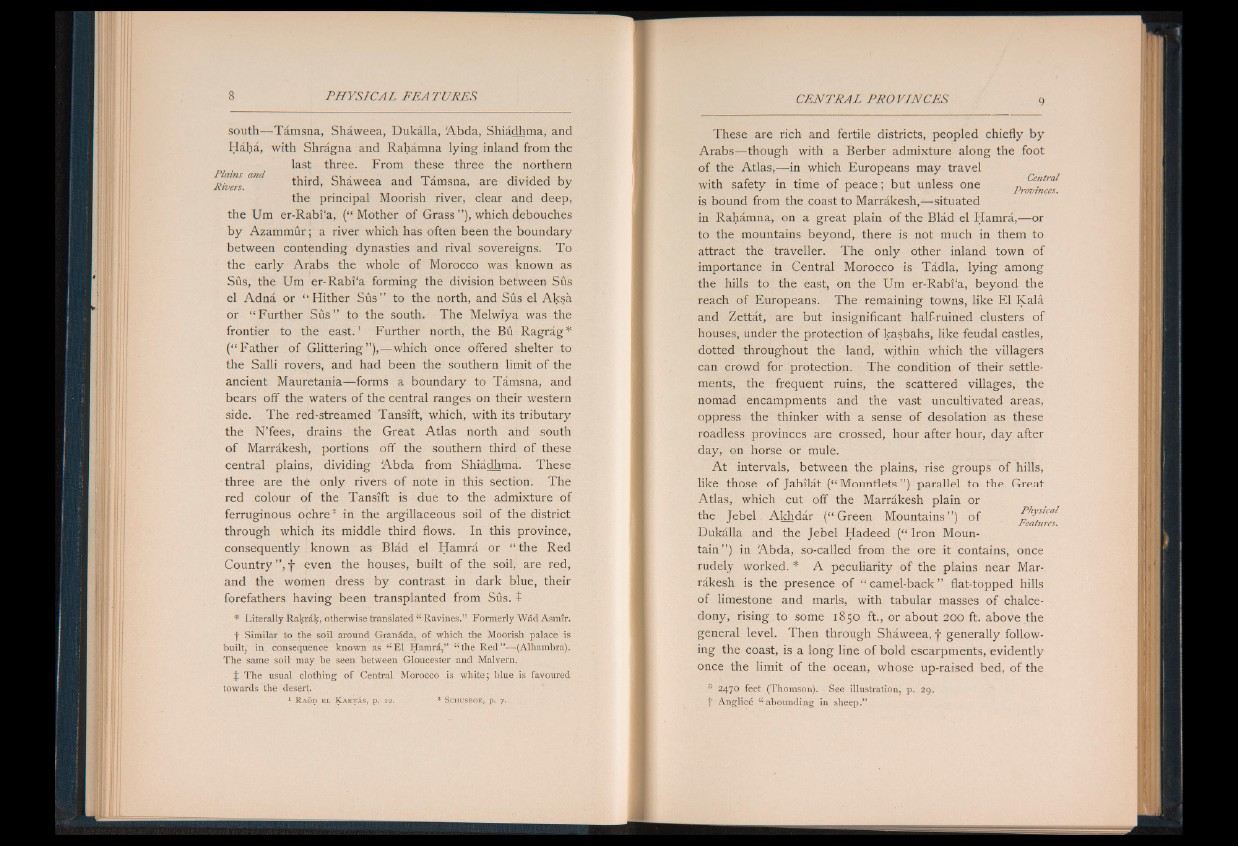
south— Tamsna, Shaweea, Dukalla, Abda, Shiadhma. and
Haha, with Shragna and Rahamna lying inland from the
last three. From these three the northern
^Rivers third, Shaweea and Tamsna, are divided by
the principal Moorish river, clear and deep,
the Um er-Rabi'a, (“ Mother of Grass ” ), which debouches
by Azammur; a river which has often been the boundary
between contending dynasties and rival sovereigns. To
the early Arabs the whole of Morocco was known as
Sus, the Um er-Rabi'a forming the division between Sus
el Adna or “ Hither Sus” to the north, and Sus el Aksa
or “ Further S u s ” to the south. The Melwiya was the
frontier to the east.1 Further north, the Bu Ragrag*
(“ Father of Glittering” ),— which once offered shelter to
the Salli rovers, and had been the southern limit of the
ancient Mauretania— forms a boundary to Tamsna, and
bears off the waters of the central ranges on their western
side. The red-streamed Tansift, which, with its tributary
the N’fees, drains the Great Atlas north and south
of Marrakesh, portions off the southern third of these
central plains, dividing Abda from Shiadhma. These
three are the only rivers o f note in this section. The
red colour of the Tansift is due to the admixture of
ferruginous ochre3 in the argillaceous soil of the district
through which its middle third flows. In this province,
consequently known as Blad el Hamra or “ the Red
Country ” , f even the houses, built of the soil, are red,
and the women dress by contrast in dark blue, their
forefathers having been transplanted from Sus. t
* Literally Rakrak, otherwise translated “ Ravines.” Formerly Wad Asmir.
f Similar to the soil around Grandda, of which the Moorish palace is
built, in consequence known as “ El Hamra,” “ the Red”— (Alhambra).
The same soil may be seen between Gloucester and Malvern.
:j: The usual clothing of Central Morocco is white; blue is favoured
towards the desert.
1 R A O D EL K a R T A S , p . 1 2 . 3 SCHUSBOE, p . 7 .
These are rich and fertile districts, peopled chiefly by
Arabs— though with a Berber admixture along the foot
of the Atlas,— in which Europeans may travel
• • CsntrCLl
with safety in time of pea ce J r 1; but unless one P„r ovin. ces.
is bound from the coast to Marrakesh,— situated
in Rahamna, on a great plain of the Blad el Hamra,— or
to the mountains beyond, there is not much in them to
attract the traveller. The only other inland town of
importance in Central Morocco is Tadla, lying among
the hills to the east, on the Um er-Rabi'a, beyond the
reach of Europeans. The remaining towns, like El Kala
and Zettat, are but insignificant half-ruined clusters of
houses, under the protection of kasbahs, like feudal castles,
dotted throughout the land, within which the villagers
can crowd for protection. The condition of their settlements,
the frequent ruins, the scattered villages, the
nomad encampments and the vast uncultivated areas,
oppress the thinker with a sense of desolation as these
roadless provinces are crossed, hour after hour, day after
day, on horse or mule.
A t intervals, between the plains, rise groups o f hills,
like those of Jabilat (“ Mountlets ” ) parallel to the Great
Atlas, which cut off the Marrakesh plain or
the Jebel Akhdar (“ Green Mountains” ) o f Physical
• — ' > Features.
Dukalla and the Jebel Hadeed (“ Iron Mountain
” ) in Abda, so-called from the ore it contains, once
rudely worked. * A peculiarity o f the plains near Marrakesh
is the presence of “ camel-back” flat-topped hills
of limestone and marls, with tabular masses of chalcedony,
rising to some 1850 ft., or about 200 ft. above the
general level. Then through Shaweea, f generally following
the coast, is a long line of bold escarpments, evidently
once the limit of the ocean, whose up-raised bed, of the
* 2470 feet (Thomson). See illustration, p. 29.
|| Anglice C£ abounding in sheep.”